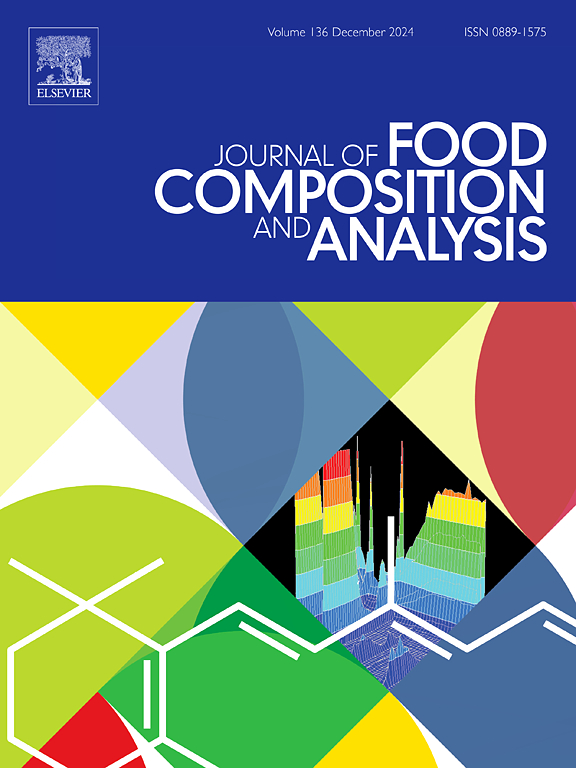Comparative analysis of nutritional ingredients of muscle in Pseudobagrus ussuriensis under pond and wild conditions
IF 4.6
2区 农林科学
Q2 CHEMISTRY, APPLIED
引用次数: 0
Abstract
This study compared muscle nutritional components of pond-cultured and wild Pseudobagrus ussuriensis. Wild group exhibited superior texture properties (adhesiveness, springiness, cohesiveness, chewiness, resilience) compared to pond group (P < 0.05). Wild group exhibited higher crude ash, lipid, and protein content but lower moisture (P < 0.05). The muscle linolenic acid (C18:3n3), SFA (saturated fatty acids), n-3PUFA (n-3 polyunsaturated fatty acids), eicosapentaenoic acid (EPA), docosahexaenoic acid (DHA) and n3/n6 of the pond group were significantly lower, while the muscle linoleic acid (C18:2n6), PUFA and n-6PUFA contents were found to be markedly higher compared to those of the wild group (P < 0.05). The total amino acids (TAA), essential amino acids (EAA) and delicious amino acids (DAA) contents of muscle in wild group were found to be markedly higher compared to those of the pond group (P < 0.05). The muscle essential amino acid index (EAAI) was above 70 % in both pond (71.76 %) and wild groups (78.78 %), which was a high-quality protein source. Pond group contained higher Fe, Na, and P but lower Se than wild group (P < 0.05). These findings highlighted the superior nutritional profile of wild Pseudobagrus ussuriensis muscle, providing a meaningful reference for consumers and a direction for future research on feed nutrition of Pseudobagrus ussuriensis.
池塘与野生条件下乌苏里拟袋鱼肌肉营养成分的比较分析
本研究比较了池养和野生乌苏里假袋鱼的肌肉营养成分。野生组的质地性能(黏附性、弹性、内聚性、咀嚼性、回弹性)优于池塘组(P <; 0.05)。野生组粗灰分、脂肪和蛋白质含量较高,水分含量较低(P <; 0.05)。池塘组肌肉亚麻酸(C18:3n3)、饱和脂肪酸(SFA)、n-3PUFA (n-3多不饱和脂肪酸)、二十碳五烯酸(EPA)、二十二碳六烯酸(DHA)和n3/n6含量显著低于野生组(P <; 0.05),而肌肉亚油酸(C18:2n6)、PUFA和n-6PUFA含量显著高于野生组(P < 0.05)。野生组肌肉总氨基酸(TAA)、必需氨基酸(EAA)和美味氨基酸(DAA)含量显著高于池塘组(P <; 0.05)。池塘组(71.76 %)和野生组(78.78 %)肌肉必需氨基酸指数(EAAI)均在70 %以上,是优质的蛋白质来源。塘组铁、钠、磷含量高于野生组,硒含量低于野生组(P <; 0.05)。这些发现凸显了野生乌苏里假袋肌优越的营养特性,为消费者提供了有意义的参考,也为今后乌苏里假袋饲料营养的研究指明了方向。
本文章由计算机程序翻译,如有差异,请以英文原文为准。
求助全文
约1分钟内获得全文
求助全文
来源期刊

Journal of Food Composition and Analysis
工程技术-食品科技
CiteScore
6.20
自引率
11.60%
发文量
601
审稿时长
53 days
期刊介绍:
The Journal of Food Composition and Analysis publishes manuscripts on scientific aspects of data on the chemical composition of human foods, with particular emphasis on actual data on composition of foods; analytical methods; studies on the manipulation, storage, distribution and use of food composition data; and studies on the statistics, use and distribution of such data and data systems. The Journal''s basis is nutrient composition, with increasing emphasis on bioactive non-nutrient and anti-nutrient components. Papers must provide sufficient description of the food samples, analytical methods, quality control procedures and statistical treatments of the data to permit the end users of the food composition data to evaluate the appropriateness of such data in their projects.
The Journal does not publish papers on: microbiological compounds; sensory quality; aromatics/volatiles in food and wine; essential oils; organoleptic characteristics of food; physical properties; or clinical papers and pharmacology-related papers.
 求助内容:
求助内容: 应助结果提醒方式:
应助结果提醒方式:


